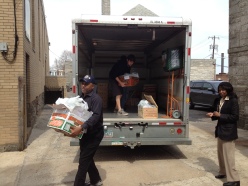Loui se Hill understands the challenges that low income individuals face when attempting to maintain a healthy, nutritional diet. Hill, a longtime volunteer worker with St. Athanasius parish in Philadelphia, says that it’s becoming more and more difficult for poor people to purchase nutritional foods. Most nutritional foods are expensive, and low income individuals simply can’t afford them.
se Hill understands the challenges that low income individuals face when attempting to maintain a healthy, nutritional diet. Hill, a longtime volunteer worker with St. Athanasius parish in Philadelphia, says that it’s becoming more and more difficult for poor people to purchase nutritional foods. Most nutritional foods are expensive, and low income individuals simply can’t afford them.
“There’s a lot of people now that are out of work, food stamps have been cut, [and] people really need the food” Hill said.
That’s why St. Athanasius teamed up with La Salle University’s Exploring Nutrition program this spring. Exploring Nutrition, according to lgulasalle.org, is a program that “aims to aims to create a model by which urban universities can, in partnership with local businesses and community organizations, utilize collective resources and expertise to have a positive impact on their neighborhood’s health and nutritional well-being”.
The Exploring Nutrition program promotes “nutritional well-being” in several different ways, but the most direct and effective method that they utilize is food drives. By partnering with a local supermarket, called The Fresh Grocer, student volunteers from La Salle University are able to deliver an abundance of fresh food to several churches and community centers all across Northwest Philadelphia.
I witnessed an Exploring Nutrition food delivery at St. Athanasius parish on April 11th. A delivery truck arrived at the church rectory around 2pm. The truck was accompanied by a handful of student volunteers from La Salle University, who quickly began unloading the food and carrying into the rectory. After the unloading process was completed, volunteers from the church distributed the food to needy neighborhood residents. All of the food was gone in about 10 minutes.
The remarkably short distribution period underscores just how important programs like Exploring Nutrition are to people that can’t afford to buy expensive produce. Louise Hill said that St Athanasius’s partnership with La Salle is important, fruitful, and rewarding.
“There are so many people that are in need. And it makes you feel good [to help]” she said. She also praised The Fresh Grocer, saying that it’s good to have “a store that’s in the community that reaches out to help people in the community”.
Limited access to healthy eating options isn’t just an issue in Northwest Philadelphia. It’s an issue that concerns people all across Philadelphia and all across the country. Poor nutrition is causing all sorts of health problems for Americans. Since the 1990’s, obesity rates have skyrocketed all across the country. Currently, the Centers for Disease Control (CDC) estimates that about 36% of U.S. adults and 17% of U.S. children are obese. Locally, about 32% of Philadelphia adults and 37% of Philadelphia children are classified as being “overweight” or “obese”. This bar graph shows how poor health rates for adults in Philadelphia have remained relatively high for the past six years
Clearly, unhealthy eating is posing a serious challenge to the entire nation. Medical professionals, activists, and politicians all have suggested various ways to alleviate this grave problem.
Dr. Edie Goldbacher, an Assistant Professor in La Salle University’s Department of Psychology, suggests that people become more self-aware of who they are and what unhealthy behaviors they are prone to. Goldbacher says that, when it comes to obesity, “genetics loads the gun, and the environment pulls the trigger”. In other words, some people are genetically predisposed to obesity, but their condition worsens when their diet is limited to snacks and junk food.
In order to prevent obesity from spiraling out of control, Goldbacher says that people need to stop “mindless eating”, and that they have to make the most from what their environment offers. Mindless or overindulgent eating can be combated through several different psychological counseling techniques, such as self-monitoring, stimulus control, and relapse prevention. Goldbacher also suggested that people analyze nutrition labels on the foods that they eat, even if they appear to be unhealthy. This can assist people in getting a lot of nutritional mileage out of their diet, even when it isn’t comprised of the best foods.
On the other hand, some people believe that direct political activism and community outreach are the best tactics to use when confronting the obesity epidemic. Professor Jule Anne Henstenburg, the Director of the Didactic Program of Nutrition at La Salle University, says that government officials can take tangible and effective steps to eliminate “food insecurity” in the United States. Food insecurity refers to the inability to acquire adequate nutrition due to income level, disability, or geographic location. Henstenburg suggested that an increases to the minimum wage and food stamp funding would go a long way in helping poor people acquire healthy food.
“When you are food insecure and hungry, the health message doesn’t sell itself”. Henstenburg said. In other words, government officials need to do more to promote healthy eating to poor individuals.
The Obama Administration has made significant strides in this area. In February, the FDA and First Lady Michelle Obama’s Let’s Move! campaign announced major changes to the nation’s food labeling system. The new improvements included changing serving sizes so that they better reflect how people eat, increasing the size of calorie labels, and indicating how many added sugars are in certain food products. President Obama and Congressional Democrats are also trying to increase the Federal minimum wage to $10.10 an hour, but Senate Republicans recently blocked an effort to pass a bill that would’ve made this a reality.
A lot of people have done a lot of great things to provide low income individuals with healthy food. However, a lot still needs to be done to fully eradicate both starvation and obesity in the United States. Exploring Nutrition is a successful, localized effort that other groups and organizations should mimic. That could go a long way in promoting healthy eating all across the nation.


